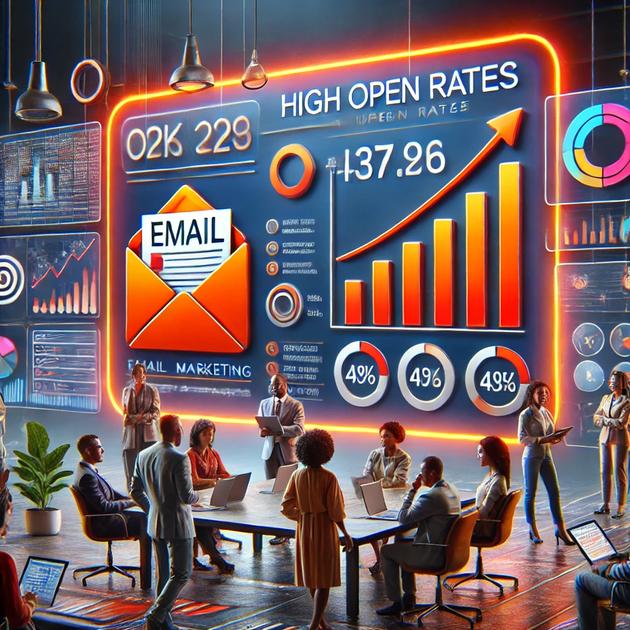In today’s digital landscape, personalized email marketing campaigns have become a crucial tool for businesses looking to stand out in crowded inboxes. With open rates soaring as high as 50%, these tailored messages are proving their worth in engaging customers and driving conversions. Let’s dive into how you can harness the power of personalization to skyrocket your email marketing success.
Understanding Personalized Email Marketing
Personalized email marketing campaigns go beyond simply addressing recipients by name. They involve crafting entire experiences that resonate with individual preferences and behaviors.
The Power of Personalization
In a world awash with generic messages, personalization cuts through the noise:
- Higher Open Rates: Emails with personalized subject lines boast 50% higher open rates.
- Improved Engagement: Tailored content leads to more clicks and interactions.
- Increased Revenue: Brands leveraging personalization see an average 10% boost in revenue per email.
How Personalized Campaigns Differ
Unlike one-size-fits-all approaches, personalized campaigns use customer data to tailor content based on:
- Demographic information
- Purchase history
- Browsing behavior
- Customer interests
This targeted approach makes each email feel more relevant and valuable to the recipient.
The Role of Customer Segmentation
To effectively personalize your emails, you need to understand and segment your audience.
What is Customer Segmentation?
Customer segmentation involves categorizing your audience into distinct groups based on shared characteristics. Common types include:
- Behavioral Segmentation: Based on actions like purchase history and brand loyalty
- Demographic Segmentation: Categories like age, gender, and income
- Geographic Segmentation: Tailoring based on location
Benefits of Segmenting Your Audience
Proper segmentation enhances your email marketing by:
- Improving Targeting: Sending the right message to the right people at the right time
- Boosting Conversion Rates: Tailored emails result in higher conversion rates
- Strengthening Customer Relationships: Building stronger connections leads to long-term loyalty
Discover how to unlock digital success with Oregon online marketing
Crafting Personalized Email Marketing Campaigns
Creating effective personalized campaigns involves several key elements:
Key Elements to Consider
- Target Audience Understanding: Know your customers’ needs and preferences
- Dynamic Content: Use content that adapts based on reader behavior
- Clear Calls to Action: Guide readers on what to do next
Utilizing Customer Data
Leverage your customer data effectively:
- Collect Relevant Data: Gather demographics, preferences, and behavior information
- Segment Your Audience: Group customers based on data insights
- Personalize Content: Adjust messaging to appeal to each segment
Designing Compelling Subject Lines and Content
Your subject line is your first impression. Make it count:
- Be clear and concise
- Incorporate personalization
- Create a sense of urgency
For email content:
- Use visual elements like images and infographics
- Incorporate interactive content like polls or quizzes
- Share personal stories that resonate with your audience
Learn how to maximize ROI with data-driven digital marketing strategies
Tools and Techniques for Effective Segmentation
To execute personalized campaigns successfully, you need the right tools and techniques.
Popular Segmentation Tools
| Tool | Key Features | Best For |
|---|---|---|
| HubSpot | Comprehensive CRM, detailed segmentation | All-in-one marketing solution |
| Mailchimp | User-friendly interface, robust segmentation | Small to medium businesses |
| ActiveCampaign | Advanced automation, behavior-based lists | Businesses focused on automation |
Data Collection Methods
Gather the right data to enhance personalization:
- Use sign-up forms on your website
- Engage customers with surveys and polls
- Analyze website visitor behavior
Maintaining Healthy Email Lists
Keep your email list clean and updated:
- Regularly remove inactive subscribers
- Continuously analyze and adjust segments
- Implement double opt-in to ensure genuine interest
Explore the power of visual content in digital marketing
Measuring ROI of Email Marketing Campaigns
Evaluating the return on investment (ROI) is crucial for understanding the effectiveness of your personalized campaigns.
Key Performance Indicators (KPIs) to Track
| KPI | What It Measures | Why It’s Important |
|---|---|---|
| Open Rates | Percentage of recipients who opened the email | Indicates subject line effectiveness |
| Click-Through Rates (CTR) | Percentage of people who clicked links in the email | Reflects engagement and content relevance |
| Conversion Rates | Percentage of recipients who completed desired action | Ultimate measure of campaign effectiveness |
| Unsubscribe Rates | Number of people who unsubscribe after receiving emails | Provides insights into content relevance |
Analyzing Engagement Metrics
To improve your campaigns:
- Conduct A/B testing on various elements
- Analyze performance across different segments
- Actively seek feedback from subscribers
Calculating ROI
Use this formula to calculate your campaign’s ROI:
ROI = ((Total Revenue from Campaign – Total Costs of Campaign) / Total Costs of Campaign) x 100
A positive ROI indicates successful engagement, while a negative ROI may require strategy reevaluation.
Discover how to choose the right digital marketing agency for your business
Testing and Optimizing Your Campaigns
Regular testing and optimization are vital for the success of your personalized email marketing campaigns.
Importance of A/B Testing
A/B testing allows you to make data-driven decisions. Test elements such as:
- Subject lines
- Email content
- Calls to action (CTAs)
Techniques for Continuous Optimization
Keep improving your campaigns by:
- Monitoring engagement metrics regularly
- Soliciting customer feedback
- Implementing automation for timely, relevant content
Gathering Customer Feedback
Engage your audience for insights:
- Deploy post-campaign surveys
- Leverage social media interactions
- Utilize customer support channels for qualitative feedback
Learn about the benefits of working with a full-service marketing agency
Challenges and Solutions in Implementing Personalized Campaigns
While personalized campaigns offer numerous benefits, they also come with challenges. Here’s how to address them:
Common Obstacles
- Data Management: Handling large volumes of customer data
- Privacy Concerns: Complying with regulations like GDPR and CCPA
- Resource Limitations: Managing sophisticated strategies with limited budgets
Strategies to Overcome Challenges
- Invest in a quality CRM system like Salesforce or HubSpot
- Educate your team on compliance regulations
- Start with basic segmentation and scale up gradually
Keeping Privacy Regulations in Mind
- Implement opt-in practices
- Be transparent about data usage
- Conduct regular data audits
Key Takeaways
- Personalized email marketing campaigns can lead to open rates as high as 50%
- Effective segmentation improves targeting and boosts conversion rates
- Use customer data to tailor content and create more engaging emails
- Regularly test and optimize your campaigns for better performance
- Address challenges like data management and privacy concerns proactively
Conclusion
Personalized email marketing campaigns for customer segmentation are no longer optional—they’re essential for businesses aiming to forge meaningful connections with their audience. By employing tailored content and targeted messaging, you can significantly enhance engagement and drive conversions.
As technology evolves, stay ahead of trends like AI and machine learning, dynamic content, and multi-channel integration. Start implementing personalized strategies today to see better ROI and create impactful, personalized experiences for your customers.
Ready to take your email marketing to the next level? Contact Nesace Media for expert guidance on creating personalized campaigns that drive results.
FAQs
What is personalized email marketing?
Personalized email marketing involves tailoring email content to individual recipients based on their preferences, behaviors, and demographics. This approach aims to create more relevant and engaging experiences for subscribers, ultimately leading to higher open and conversion rates.
Why is customer segmentation important in email marketing?
Customer segmentation allows marketers to divide their audience into smaller, more targeted groups based on shared characteristics. This enables the delivery of tailored content that resonates with each segment, improving engagement and driving more effective results from marketing campaigns.
How can I start implementing personalized email marketing campaigns?
To implement personalized email marketing campaigns:
- Collect relevant data on your subscribers (purchase history, preferences, engagement levels)
- Segment your audience based on this data
- Create targeted content for each segment
- Test different approaches and analyze results to refine your strategies
What tools can help with personalized email marketing and segmentation?
Several tools can assist with personalized email marketing and segmentation:
- Mailchimp
- HubSpot
- ActiveCampaign
These platforms offer features for data collection, audience segmentation, and automation, allowing marketers to effectively manage their personalized campaigns.
How can I measure the success of my personalized email marketing campaigns?
Measure the success of your personalized email marketing campaigns by tracking key performance indicators (KPIs) such as:
- Open rates
- Click-through rates
- Conversion rates
- Unsubscribe rates
Analyze these metrics to determine the effectiveness of your campaigns and make necessary adjustments to improve future performance.




